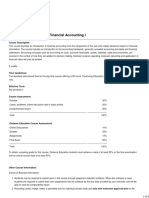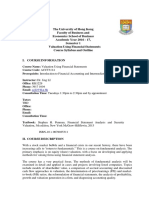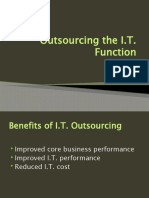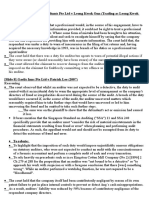AUDIT
AUDIT
Uploaded by
mulu melakCopyright:
Available Formats
AUDIT
AUDIT
Uploaded by
mulu melakCopyright
Available Formats
Share this document
Did you find this document useful?
Is this content inappropriate?
Copyright:
Available Formats
AUDIT
AUDIT
Uploaded by
mulu melakCopyright:
Available Formats
Name of college : SATA Technology & Business College
Name of College/Faculty: BUSINESS
Name of Department: Accounting and Finance Program
Instructor:- Tesfaye G.
Course Information
Course code ACFN 422
Course Title Auditing Principles and Practices II
Degree Program BA Degree in Accounting and Finance
Course At the end of the course the student is expected to:
Objectives & • Apply his knowledge of auditing theory, auditing standards, techniques and procedures to
Competences to practical situations commonly encountered relative to an opinion audit.
be Acquired • Be acquainted the principles that underlie audit of Balance Sheet and Income Statement
accounts
• Enumerate and understand the audit objectives for the audit of major accounts;
• Develop audit procures for the audit of major accounts; and
• Comprehend the significance of professional competence, independence, and mental
integrity in the practice of accountancy.
• Be committed to bringing about a prevalence of good reporting practice and contribute to
the pursuit of social justice and fairness.
Course The course builds on the knowledge gained in Auditing I. It covers an in depth practical aspects of
Description topics introduced in Auditing I and brings in new concepts as well. The course introduces audit
sampling in general and goes on to application of statistical tools in tests of controls and balances.
The technical application of auditing procedures for balance sheet and income statement accounts
in an audit undertaking are the foremost subject matters of the course. Audit of systems that include
EDP application along with tools and techniques used in evaluation and understanding of internal
control in such environments will be introduced.
WEEKS Course Contents Reading
1.Sampling in Auditing
1.1Rationale for and methods of Audit Sampling
1.2Audit sampling for tests of controls
1.3Audit sampling for substantive tests
2. Audit of Cash and Marketable Securities
2.1. Internal control over cash transactions, receipts and
disbursements
2.2. Audit program for cash
2.3. Internal control over Marketable securities
2.4. Audit program for marketable securities
3. Audit of Receivables and Sales
3.1. Internal control over Sales transactions, and Accounts
Receivable
3.2. Internal control over Notes Receivable
3.3. Audit program for Receivables and Sales
4. Inventories and Cost of goods sold
4.1. Internal control over Inventories and Cost of goods sold
4.2. Audit program for Inventories and Cost of goods sold
5. Audit of Fixed Assets
5.1. Internal control over plant and equipment
5.2. The plant and equipment budget
5.3. Audit program for property plant and equipment
6. Audit of current liabilities
6.1. Internal control over Accounts payable
6.2. Audit program for accounts payable and other
liabilities
7. Audit of Debt and Equity capital
7.1. Internal control over interest bearing debt
7.2. Audit programs for interest bearing debt
7.3. Internal control over equity capital and dividends
7.4. Audit program for capital stock
7.5. Audit of sole proprietorships, and partnerships
7.6. Disclosure of contingencies
Teaching & The teaching and learning methodology include lecturing, discussions, problem solving, and
Learning analysis. Take-home assignment will be given at the end of each chapter for submission
Methods/strateg within a week. Solution to the assignments will be given once assignments are collected.
y Cases with local relevance will also be given for each chapter for group of students to
present in a class room. The full and active participation of students is highly encouraged.
Assessment
/Evaluation The evaluation scheme will be as follows:
Test 1 Test2 Test 3 Quiz1 Assignment 1 Final Total
/mid/
10% 10% 20% 5% 15% 40% 100%
Work load in
hours Hours Required
Self- Total Hrs
Lectures Lab Assessments Tutorials Studies Assignment Advising
48 - 10 12 55 - - 135
Roles of the He/she will come to the class regularly on time and deliver the lecture in a well-organized
Instructor manner. Besides, at the end of each class he/she gives reading assignment for the next
class. He/she will make sure that proper assessments are given. He/she is also responsible
to give feedback for each assessment.
Roles of the The success of this course depends on the students’ individual and collective contribution to
students the class discussions. Students are expected to participate voluntarily, or will be called upon,
to contribute to set exercises and problems. Students are also expected to read the assigned
readings and prepare the cases before each class so that they could contribute effectively to
class discussions. Students must attempt assignments by their own. Proficiency in this course
comes from individual knowledge and understanding. Copying the works of others is
considered as serious offence and leads to disciplinary actions.
Text and Text Book: Arens and Loebeck
reference books Reference Books
Reference Books
Meigs et al Principles of Auditing, 10th ed.
Hayes, Dassen, Schilder & Wallage, Principles of Auditing, 2nd ed. 2005
You might also like
- Chapter 8 Controls in The Construction IndustryDocument6 pagesChapter 8 Controls in The Construction IndustryHazraphine LinsoNo ratings yet
- Philippine Standard On Auditing 120Document7 pagesPhilippine Standard On Auditing 120Zach RiversNo ratings yet
- Course OutlineDocument3 pagesCourse Outlinefekadegebretsadik478729No ratings yet
- UntitledDocument124 pagesUntitledAndre CalitzNo ratings yet
- ACCT 215 - Introductory Financial Accounting I: Course DescriptionDocument5 pagesACCT 215 - Introductory Financial Accounting I: Course DescriptionJayden FrosterNo ratings yet
- ACCT3114A - Valuation Using Financial Statements - Dr. Jing LiDocument8 pagesACCT3114A - Valuation Using Financial Statements - Dr. Jing LiTheo GalvannyNo ratings yet
- Auditing I Course OutlineDocument3 pagesAuditing I Course OutlineMeseret AsefaNo ratings yet
- Course Outline Acctg. 35 A Auditing Iassurance Concept and Appli. 1Document5 pagesCourse Outline Acctg. 35 A Auditing Iassurance Concept and Appli. 1jedidiah eliotNo ratings yet
- Master Class Internal Audit Essentials 1Document11 pagesMaster Class Internal Audit Essentials 1Abhishek PareekNo ratings yet
- Module Financial Statement AnalysisDocument5 pagesModule Financial Statement Analysismiami321vidalNo ratings yet
- ACCT 100 POFA Course Outline Fall Semester 2022-23Document6 pagesACCT 100 POFA Course Outline Fall Semester 2022-23MuhammadNo ratings yet
- Gedion FDocument4 pagesGedion FGedionNo ratings yet
- Performance Management SyllabusDocument6 pagesPerformance Management SyllabusThảo Thiên ChiNo ratings yet
- MACC7014 Advanced Corporate Control and Risk Management 2023-24Document6 pagesMACC7014 Advanced Corporate Control and Risk Management 2023-24zhouzhousatNo ratings yet
- FA II OutlineDocument6 pagesFA II OutlineAbdulwedud NuredinNo ratings yet
- ACCT 100 POFA Course Outline Fall Semester 2022-23 updated (2)Document6 pagesACCT 100 POFA Course Outline Fall Semester 2022-23 updated (2)Shara xxNo ratings yet
- Chartered Accountants Australia - Audit & Assurance (2022, Chartered Accountants Australia) - Libgen - LiDocument344 pagesChartered Accountants Australia - Audit & Assurance (2022, Chartered Accountants Australia) - Libgen - LiKreshen Shunmugam100% (1)
- Auditing and Assurance - Concepts and Application - Week 1 Module 2 PDFDocument10 pagesAuditing and Assurance - Concepts and Application - Week 1 Module 2 PDFLuisito0% (1)
- 01 Syllabus - Principles of Auditing - 2021Document5 pages01 Syllabus - Principles of Auditing - 2021My DgNo ratings yet
- AC4342 Course Outline 2021Document5 pagesAC4342 Course Outline 2021Cheuk Ling SoNo ratings yet
- Lahore University of Management Sciences ACCT 100 - Principles of Financial AccountingDocument6 pagesLahore University of Management Sciences ACCT 100 - Principles of Financial AccountingAli Zain ParharNo ratings yet
- Ahore Chool OF Conomics: Cost Accounting (ACC-302)Document8 pagesAhore Chool OF Conomics: Cost Accounting (ACC-302)he20003009No ratings yet
- Armgt402 Module November 2023Document5 pagesArmgt402 Module November 2023Mapako Jonasi LishahNo ratings yet
- 47289bosfinal p3 Mod1 InitpagesDocument22 pages47289bosfinal p3 Mod1 InitpagesChandana RajasriNo ratings yet
- Syllabus Aku 3302 - Auditing 2Document6 pagesSyllabus Aku 3302 - Auditing 2alfianaNo ratings yet
- Name of University: Name of College/Faculty: Name of Department: Accounting and Finance ProgramDocument3 pagesName of University: Name of College/Faculty: Name of Department: Accounting and Finance ProgramzemeNo ratings yet
- Operational Audit Overview: Mountain Province State Polytechnic CollegeDocument26 pagesOperational Audit Overview: Mountain Province State Polytechnic CollegeAlona ColiaenNo ratings yet
- ACC202 - Managerial Accounting - Trimester 1 2024Document13 pagesACC202 - Managerial Accounting - Trimester 1 2024Huong Nguyen Thi XuanNo ratings yet
- Auditing Principles and Practices IIDocument2 pagesAuditing Principles and Practices IIetebark h/michale100% (1)
- Course Out Line Principle IIDocument4 pagesCourse Out Line Principle IIabenezer nardiyasNo ratings yet
- ACCT 100-Principles of Financial Accounting - Fall 2018-19Document7 pagesACCT 100-Principles of Financial Accounting - Fall 2018-19Qudsia AbbasNo ratings yet
- MFIN6205 Financial Risk Management For Financial Instutions S22017Document8 pagesMFIN6205 Financial Risk Management For Financial Instutions S22017SriHariKalyanBNo ratings yet
- CA Program Subject Outline EB CACC1500Document10 pagesCA Program Subject Outline EB CACC1500mp1085No ratings yet
- In-Class MBA 507 Course Outline (JT)Document8 pagesIn-Class MBA 507 Course Outline (JT)Suma ReddyNo ratings yet
- Principles of Financial AccountingDocument7 pagesPrinciples of Financial Accountinghnoor94No ratings yet
- 2030 - ACC2008 - Management Accounting and Control - Module Profile - Students - 9 May 2021Document8 pages2030 - ACC2008 - Management Accounting and Control - Module Profile - Students - 9 May 2021JJ FrystNo ratings yet
- FAR 3 Intermediate Accounting I SyllabusDocument8 pagesFAR 3 Intermediate Accounting I SyllabusABMAYALADANO ,ErvinNo ratings yet
- School of Business & Management: Course Outline & Accompanying Teaching & Learning PlanDocument6 pagesSchool of Business & Management: Course Outline & Accompanying Teaching & Learning PlanGurmanjot KaurNo ratings yet
- School of Business & Management: Course Outline & Accompanying Teaching & Learning PlanDocument6 pagesSchool of Business & Management: Course Outline & Accompanying Teaching & Learning PlanGurmanjot KaurNo ratings yet
- ACCT 100-Principle of Financial Accounting-Saira RizwanDocument6 pagesACCT 100-Principle of Financial Accounting-Saira Rizwanraziqachaudhry9665No ratings yet
- 4 - Financial Management, Course Specification, Fall 2021Document6 pages4 - Financial Management, Course Specification, Fall 2021ASIMLIBNo ratings yet
- Subject Description Form: A. B. C. DDocument3 pagesSubject Description Form: A. B. C. DLi LianaNo ratings yet
- Audit-I Course OutlineDocument5 pagesAudit-I Course Outlinetibebu5420No ratings yet
- Principles of Financial AccountingDocument7 pagesPrinciples of Financial AccountingmfaizanzahidNo ratings yet
- Modul Finance 2020 PDFDocument96 pagesModul Finance 2020 PDFMutiaraMorentNo ratings yet
- AF5115Document5 pagesAF5115Chin LNo ratings yet
- CIIA Programme Information BookletDocument6 pagesCIIA Programme Information BookletCarl RossNo ratings yet
- Learning Unit 9_Substantive proceduresDocument15 pagesLearning Unit 9_Substantive proceduresNyasha NyathiNo ratings yet
- 410-A11-DW-07113 - Accounting 1 - Outline - SEPT 8 2022Document8 pages410-A11-DW-07113 - Accounting 1 - Outline - SEPT 8 2022muhammadreza vatanparastNo ratings yet
- Course OutlineDocument6 pagesCourse Outlinekayk1leroyNo ratings yet
- ISO IEC 17025 PresentationDocument18 pagesISO IEC 17025 PresentationVishal MandlikNo ratings yet
- AC5511 +1819A-Course+OutlineDocument6 pagesAC5511 +1819A-Course+Outline靳雪娇No ratings yet
- Course Managerial Accounting Number MBA520: Miuniversity - EduDocument11 pagesCourse Managerial Accounting Number MBA520: Miuniversity - EduTheresa BrownNo ratings yet
- ACC201 PA Trimester 1 2022Document19 pagesACC201 PA Trimester 1 2022Ngan Duong Nguyen ThanhNo ratings yet
- Course Outline Acctg. E1.1 Operations Auditing Guide For LearnersDocument5 pagesCourse Outline Acctg. E1.1 Operations Auditing Guide For Learnersjedidiah eliotNo ratings yet
- Governance, Business Ethics, Risk Management and Internal ControlDocument6 pagesGovernance, Business Ethics, Risk Management and Internal ControlmhadzmpNo ratings yet
- Financial Accounting and Information Systems: Class MBADocument6 pagesFinancial Accounting and Information Systems: Class MBADaniyal JunaidNo ratings yet
- Solved Manaual of Fundamentals of FinanceDocument14 pagesSolved Manaual of Fundamentals of Financemansoor mahmoodNo ratings yet
- Manacc Standard (April 2015)Document35 pagesManacc Standard (April 2015)CyrilNo ratings yet
- Assessment_Brief_M502_ September 2024Document8 pagesAssessment_Brief_M502_ September 2024jatinNo ratings yet
- CISSP Domain 1 Study Guide ( Updated 2024 ) With Practice Exam Questions, Quizzes, Flash Cards: CISSP Study Guide - Updated 2024, #1From EverandCISSP Domain 1 Study Guide ( Updated 2024 ) With Practice Exam Questions, Quizzes, Flash Cards: CISSP Study Guide - Updated 2024, #1No ratings yet
- Information Security Management Professional based on ISO/IEC 27001 Courseware revised Edition– EnglishFrom EverandInformation Security Management Professional based on ISO/IEC 27001 Courseware revised Edition– EnglishNo ratings yet
- App FDocument50 pagesApp Fmulu melakNo ratings yet
- ACFN 221, Ch. III-3Document28 pagesACFN 221, Ch. III-3mulu melakNo ratings yet
- CH 2 Audit of CashDocument14 pagesCH 2 Audit of Cashmulu melakNo ratings yet
- Chapter TwoDocument64 pagesChapter Twomulu melakNo ratings yet
- CH 7 Audit of Debt & Equity CapitalDocument55 pagesCH 7 Audit of Debt & Equity Capitalmulu melakNo ratings yet
- Income Tax Regulations CompressedDocument66 pagesIncome Tax Regulations Compressedmulu melakNo ratings yet
- CH 3Document59 pagesCH 3mulu melak100% (1)
- Board Mandate enDocument6 pagesBoard Mandate enamvcivilNo ratings yet
- The Effect of Using Accounting Information Systems On The Quality of Accounting Information According To Users Perspective in JordanDocument18 pagesThe Effect of Using Accounting Information Systems On The Quality of Accounting Information According To Users Perspective in JordanMae Ciarie YangcoNo ratings yet
- ECA GMP Auditor ForumfDocument6 pagesECA GMP Auditor ForumfscientificresourcesbackupNo ratings yet
- Indang Cavite ES2019nhaulingDocument5 pagesIndang Cavite ES2019nhaulingMS NIQUEENo ratings yet
- NIST 800 171 Compliance Scoping GuideDocument84 pagesNIST 800 171 Compliance Scoping GuideridteamNo ratings yet
- QAP CI Flsnged PipesDocument11 pagesQAP CI Flsnged PipesNaveen NagisettiNo ratings yet
- Unit - 2 Study Material ACGDocument18 pagesUnit - 2 Study Material ACGAbhijeet UpadhyayNo ratings yet
- Standard Operating Procedures (SOP)Document4 pagesStandard Operating Procedures (SOP)varun2860No ratings yet
- Aviation Maintenance Management ProgramsDocument7 pagesAviation Maintenance Management ProgramstmhoangvnaNo ratings yet
- Annual Audit Report: Republic of The Philippines Commission On Audit Regional Office No. IX Zamboanga CityDocument8 pagesAnnual Audit Report: Republic of The Philippines Commission On Audit Regional Office No. IX Zamboanga CityJuan Luis LusongNo ratings yet
- Outsourcing The I.T. FunctionDocument6 pagesOutsourcing The I.T. FunctionWilbert Carlo RachoNo ratings yet
- Unit 4Document13 pagesUnit 4vikashsagar231105No ratings yet
- Jade Global Gap V4 Awareness TrainingDocument50 pagesJade Global Gap V4 Awareness TrainingJohnson Gitonga NderiNo ratings yet
- Redemption of Shares NotesDocument14 pagesRedemption of Shares NotesAhmed NiazNo ratings yet
- Gov AssDocument3 pagesGov AssRomel KiwangNo ratings yet
- 26071-100-GPP-GCX-00162 - Method Statement of Bore Piling Work in Interconnecting Piperacks (Unit PR-321-21 (R84) and Unit PR-321-03 (R12) )Document38 pages26071-100-GPP-GCX-00162 - Method Statement of Bore Piling Work in Interconnecting Piperacks (Unit PR-321-21 (R84) and Unit PR-321-03 (R12) )Amy Amaliah HSENo ratings yet
- Business Letters by Alistair KingDocument22 pagesBusiness Letters by Alistair KingNalaka Santhajeewa100% (1)
- Halal Certification and Halal AssuranceDocument43 pagesHalal Certification and Halal Assurancedean karledNo ratings yet
- Level 3 Integrated Advisory ServicesDocument1 pageLevel 3 Integrated Advisory ServicesAce RamosoNo ratings yet
- Nursing AuditDocument26 pagesNursing AuditJoe ShewaleNo ratings yet
- Audit Report Sharfabaad Outlet 5th Aug 2021Document14 pagesAudit Report Sharfabaad Outlet 5th Aug 2021sajid waqasNo ratings yet
- Case Notes - Topic 6Document8 pagesCase Notes - Topic 6meiling_1993No ratings yet
- Cambridge International AS & A Level: Accounting 9706/33Document14 pagesCambridge International AS & A Level: Accounting 9706/33Shahriar OntherunNo ratings yet
- Faktor-Faktor Yang Mempengaruhi Kapabilitas Internal Audit Kompetensi, Pendidikan, Dan Pengalaman AuditDocument6 pagesFaktor-Faktor Yang Mempengaruhi Kapabilitas Internal Audit Kompetensi, Pendidikan, Dan Pengalaman AuditMuhammad RizkiNo ratings yet
- Apg - Document and Records ControlDocument6 pagesApg - Document and Records ControlArlene DacpanoNo ratings yet
- Road Safety Audit (RSA) : Dr. Mohd Rosli Mohd Hasan School of Civil EngineeringDocument33 pagesRoad Safety Audit (RSA) : Dr. Mohd Rosli Mohd Hasan School of Civil EngineeringNasrul TorresNo ratings yet
- Risk AssessmentDocument9 pagesRisk AssessmentDhinakaran100% (2)
- Application of Cleaner Production As An Important Sustainable Strategy in The Ceramic Tile Plant e A Case Study in Guangzhou, China (Huang-China-2013)Document9 pagesApplication of Cleaner Production As An Important Sustainable Strategy in The Ceramic Tile Plant e A Case Study in Guangzhou, China (Huang-China-2013)juan diazNo ratings yet
































































































